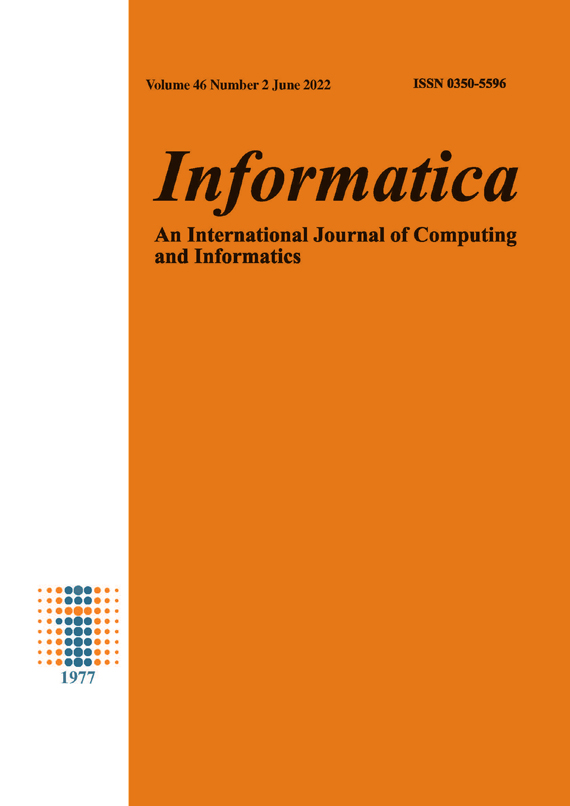An Efficient Procedure for Removing Salt and Pepper Noise in Images
DOI:
https://doi.org/10.31449/inf.v46i2.3530Abstract
In this paper, we propose an efficient algorithm for removing salt and pepper noise in images. The process of denoising is implemented in two stages: noise detection followed by noise removal. For noise detection, two extreme intensity values in an image are used to detect possible “noise pixels”. For noise removal, the switching mechanism only selects “noise pixels” for processing to avoid altering any fine image details, and only the identified noise-free pixels are used to achieve better denoising performance. Two filtering techniques, the edge-preserving filtering (EPF) and the extremum-compressing median filtering (ECMF), are employed for edge-preserving and noise removal. The EPF provides higher correlation between the corrupted pixel and neighborhood pixel, which gives rise to better edge preservation. The ECMF can yield an appropriate estimation by selecting the median pixel from the noise-free pixels of current filtering window. The proposed algorithm is tested on different images and provides a better restoration performance over some of the salt and pepper noise filters.References
Huang TS, Yang GJ, Tang GY (1979). A fast two-dimensional median filtering algorithm. IEEE Transactions on Acoustics, Speech, and Signal Processing, 27(1), pp. 13–18.
Brownrigg DRK (1984). The weighted median filter. Communications of the ACM, 27(8), pp. 807–818.
Ko SJ, Lee YH (1991). Center weighted median filters and their applications to image enhancement. IEEE Transactions on Circuits and Systems, 38(9), pp. 984–993.
Sun T, Neuvo Y (1994). Detail-preserving median based filters in image processing. Pattern Recognition Letters, 15(4), pp. 341–347.
Hwang H, Haddad RA (1995). Adaptive median filters: New algorithms and results. IEEE Transactions on Image Processing, 4(4), pp. 499–502.
Chen T, Ma KK, Chen LH (1999). Tri-state median filters for image denoising. IEEE Transactions on Image Processing, 8(12), pp. 1834–1838.
Chen T, Wu HR (2001). Adaptive impulse detection using center-weighted median filter. IEEE Signal Processing Letters, 8(1), pp. 1–3.
Srinivasan KS, Ebenezer D (2007). A new fast and efficient decision-based algorithm for removal of high-density impulse noises. IEEE Signal Processing Letters, 14(3), pp. 189–192.
Kkishorebabu V, Varatharajan R (2020). A decision based unsymmetrical trimmed modified winsorized variants for the removal of high density salt and pepper noise in images and videos. Computer communications, 154, pp. 433-441.
Thanh DNH, Hai NH, Prasath VBS, Hieu LM, Tavares JMRS (2020). A two-stage filter for high density salt and pepper denoising. Multimedia tools and applications, 79(29), pp.21013-21035.
Chen PY, Lien CY (2008). An efficient edge-preserving algorithm for removal of salt-and-pepper noise. IEEE Signal Processing Letters, 15, pp. 833–836.
Toh KKV, Isa NAM (2010). Noise adaptive fuzzy switching median filter for salt-and-pepper noise reduction. IEEE Signal Processing Letters, 17(3), pp. 281–284.
Wang Y, Wang J, Song X, Han L (2016). An efficient adaptive fuzzy switching weighted mean filter for salt-and-pepper noise removal. IEEE Signal Processing Letters, 23(11), pp. 1582–1586.
Singh V, Dev R, Dhar NK, Agrawal P, Verma NK (2018). Adaptive type-2 fuzzy approach for filtering salt and pepper noise in grayscale images, IEEE Transactions Fuzzy system, 26(5), pp.3170-3176.
Chan RH, Ho CW, Nikolova M (2005). Salt-and-pepper noise removal by median-type noise detectors and detail preserving regularization. IEEE Transactions on Image Processing, 14(10), pp. 1479–1485.
Thanh DNH, Thanh LT, Hien NN and Prasath VBS (2020), Adaptive total vatiation L1 regularization for salt and pepper image denoising. Optik, 208, pp. 1-10.
Jayasree PS, Raj P, Kumar P, Siddavatam R, Ghrera SP (2012). A fast novel algorithm for salt and pepper image noise cancellation using cardinal B-splines. Signal Image Video Process, 5(2), pp. 1–8.
Bai T, Tan J, Hu M, Wang Y (2014). A novel algorithm for removal of salt and pepper noise using continued fractions interpolation. Signal Processing, 102, pp. 247–255.
Ramadan ZM (2012). Efficient restoration method for images corrupted with impulse noise. Circuits, Systems, and Signal Processing, 31, pp. 1397–1406.
Enginoglu S, Erkan U, Memis S (2019), Pixel similarity-based adaptive riesz mean filter for salt-and-pepper noise removal, Multimedia Tools Applications,78, 35401-35418.
Xu G, Tan J (2014). A universal impulse noise filter with an impulse detector and nonlocal means. Circuits, Systems, and Signal Processing, 33, pp. 421–435.
Downloads
Published
Issue
Section
License
I assign to Informatica, An International Journal of Computing and Informatics ("Journal") the copyright in the manuscript identified above and any additional material (figures, tables, illustrations, software or other information intended for publication) submitted as part of or as a supplement to the manuscript ("Paper") in all forms and media throughout the world, in all languages, for the full term of copyright, effective when and if the article is accepted for publication. This transfer includes the right to reproduce and/or to distribute the Paper to other journals or digital libraries in electronic and online forms and systems.
I understand that I retain the rights to use the pre-prints, off-prints, accepted manuscript and published journal Paper for personal use, scholarly purposes and internal institutional use.
In certain cases, I can ask for retaining the publishing rights of the Paper. The Journal can permit or deny the request for publishing rights, to which I fully agree.
I declare that the submitted Paper is original, has been written by the stated authors and has not been published elsewhere nor is currently being considered for publication by any other journal and will not be submitted for such review while under review by this Journal. The Paper contains no material that violates proprietary rights of any other person or entity. I have obtained written permission from copyright owners for any excerpts from copyrighted works that are included and have credited the sources in my article. I have informed the co-author(s) of the terms of this publishing agreement.
Copyright © Slovenian Society Informatika








